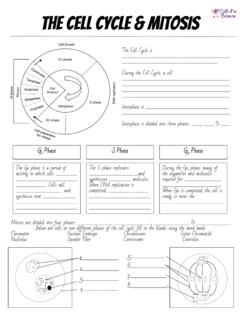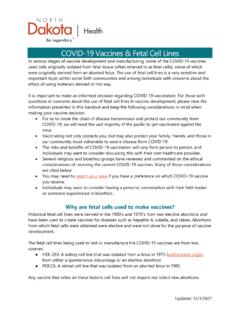Transcription of Cell Cycle and Cell Division - Phoenix College
1 Cell Cycle and Cell DivisionWhy Do cells Divide? Reproduction Growth and Development Tissue RenewalThe Cell CycleWhat Structures Do Divide When The Cell Divides? DNA chromosomes nucleus33%33%33% is a Chromosome?What is a Chromosome?A chromosome is a molecule of DNA True False50%50% many molecules of DNA are there in one of your skin cells ?2346921225%25%25%25% on the Arrangement of Chromosomes Organisms are: Haploid (n) Diploid (2n)Only one chromosome of each typeNumber of chromosomes= n= Two chromosomes of each type, one from each parentNumber of chromosomes= 2n= Homologous ChromosomesHumans are ___ organisms. haploid diploid tetraploid33%33%33% Duplicate During the S Phase During the S phase all the chromosomes duplicate When a chromosome duplicates, it produces a replica chromosome referred to as chromatidor sister chromatid Sister chromatidsare joint at the centromereHow Human Chromosomes Look After Chromosome DuplicationHuman KaryotypeThese chromosomes are ___ and made of ___ sister chromatids.
2 Not duplicated/ two duplicated/ two duplicated/ four33%33%33% duplicated/ fourCell Division : What is it?Mother Cell Daughter CellsCell Division in Asexual Reproduction: Binary FissionCell Division in Eukaryotes: Mitosis Mitosis is the mechanism by which somatic eukaryotic cells produce identical daughter cells Mitosis produces two identical, diploid daughter cells Mitosis involves partition of both cytoplasmicand nuclear structures Mitosis consist of five phases: prophase, prometaphase, metaphase, anaphase, and telophase After telophase, the mother cell splits into two and produces two daughter cells by undergoing a process referred to as cytokinesisCell Division in Eukaryotes: MitosisCell Division in Eukaryotes: MitosisSpindle ApparatusDivision of Nuclear and CytoplasmicStructures: CytokinesisThis mitotic cell is in ____ prophase metaphase anaphase telophase cytokinesis20%20%20%20%20% mitotic cell is in ____ prophase metaphase anaphase telophase cytokinesis20%20%20%20%20% mitotic cell is in ____ prophase metaphase anaphase telophase cytokinesis20%20%20%20%20% of Cell Division .
3 Uncontrolled Cell DivisionUncontrolled Cell Division : Cancerous CellsUncontrolled Cell Division : Cancerous CellsCell Division in Sexual Reproduction: MeiosisMeiosis: Oogenesisand SpermiogenesisCell Division in Sexual Reproduction: Meiosis Meiosis is the mechanism by which eukaryotic cells produce mature sex cells or gametes Meiosis produces four haploid cells (gametes) Meiosis involves partition of both cytoplasmicand nuclear structures Meiosis consists of Meiosis I and Meiosis II. Both phases are followed by cytokinesis. Meiosis I consists of four phases: prophase I, metaphase I, anaphase I, and telophaseI. Meiosis II consists of four phases: prophase II, metaphase II, anaphase II, and telophaseII. Oogenesisis the production of mature eggs; spermiogenesisis the production of mature sperm cellsMeiosis and Sexual ReproductionMature gametes are: haploid diploid50%50% and Sexual Reproduction Mature gametes (eggs and sperm cells ) are produced after meiosis Mature gametes (haploid) carry on fertilization to produce a zygote (diploid).
4 Meiosis ensures that the number of chromosomes is maintained from parents to offspringMeiosis: An Overview Meiosis consists of Meiosis I and Meiosis II. Cytokinesisfollows after each phasePhases of Meiosis ICrossing Over (Prophase I) Crossing over is the interchange of genetic material between homologous chromosomes Crossing over occurs during prophase I After crossing over, sets of four chromosomes or tetrads are formedAt the end of anaphase I, is the cell haploid or diploid? haploid diploid50%50% of Meiosis IIMitosis and Meiosis ComparedAt the end of meiosis I, two haploid cells are produced True False50%50% the end of meiosis II, two haploid cells (gametes) are produced True False50%50%











